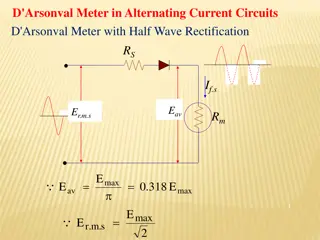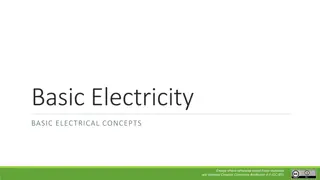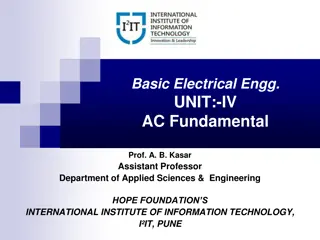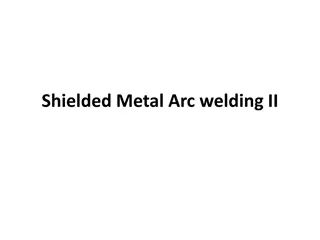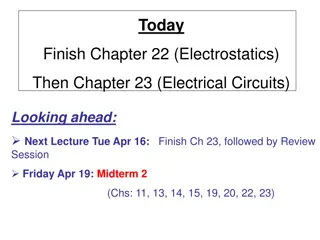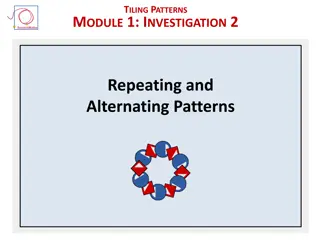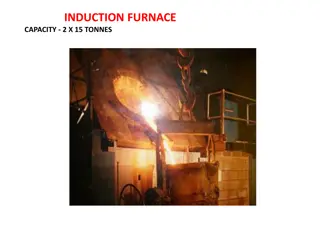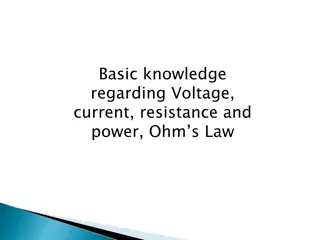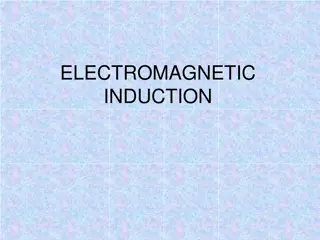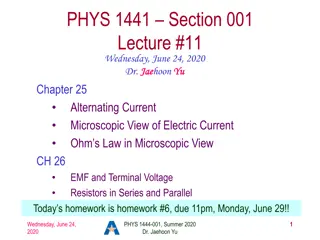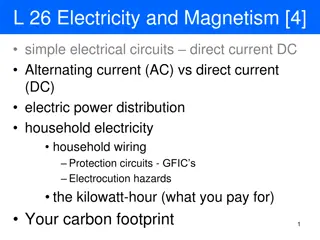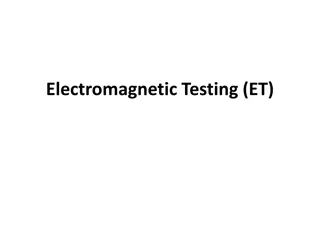Alternating Current Fundamentals
Alternating current (A.C.) constantly changes in amplitude and direction at regular intervals. Learn about its properties like frequency, time period, amplitude, instantaneous and average values, peak value, derivation of average and RMS value, and more.
Download Presentation

Please find below an Image/Link to download the presentation.
The content on the website is provided AS IS for your information and personal use only. It may not be sold, licensed, or shared on other websites without obtaining consent from the author.If you encounter any issues during the download, it is possible that the publisher has removed the file from their server.
You are allowed to download the files provided on this website for personal or commercial use, subject to the condition that they are used lawfully. All files are the property of their respective owners.
The content on the website is provided AS IS for your information and personal use only. It may not be sold, licensed, or shared on other websites without obtaining consent from the author.
E N D
Presentation Transcript
CHAPTER 6 (BEE) AC Fundamentals GPES MANESAR (ECE DEPTT.)
WHAT IS ALTERNATING CURRENT (A.C.)? Alternating current is the current which constantly changes in amplitude, and which reverses direction at regular intervals. Because the changes are so regular, alternating voltage and current have a number of properties associated with any such waveform. These basic properties include : Frequency: It is the number of complete cycles that occurred in one second. The frequency of the wave is commonly measured in cycles per second (cycles/sec) and expressed in units of Hertz (Hz). It is represented in mathematical equations by the letter f .
Time Period: It is the duration of time required for the quantity to complete one cycle. And is denoted by T. This is reciprocal of frequency. Amplitude: Mathematically, the amplitude of a sine wave is the value of that sine wave at its peak. This is the maximum value, positive or negative, that it can attain.
A.C. Fundamentals Instantaneous Value: The instantaneous value of an alternating voltage or current is the value of voltage or current at one particular instant. Average Value: The average value of an alternating current or voltage is the average of all the instantaneous values during one alternation. Since the voltage increases from zero to peak value and decreases back to zero during one alternation, the average value must be some value between those two limits.
Peak Value[Ip] PeakValue[Ip] Refer to figure, it is the maximum value of voltage [Vp] or Current [Ip]. The peak value applies to both positive and negative values of the cycle.
Derivation of Average Value of Current [Iav] The average value of A.C. is the average over one complete cycle and is clearly zero, because there are alternately equal positive and negative half cycles. Alternating current is represented as I = I0 sin t
PHASORS In an a.c. circuit, the e.m.f. or current vary sinusoidally with time and may be mathematically represented as E = E0sin t and I = I0 sin ( t ) where is the phase angle between alternating e.m.f. and current and = 2 f. The quantities, such as alternating e.m.f. and alternating current are calledphasor. Thus a phasor is a quantity which varies sinusoidally with time and represented as the projection of rotating vector.
Phasor Diagram The generator at the power station which produces our A.C. mains rotates through 360 degrees to produce one cycle of the sine wave form which makes up the supply (fig1). In the fig 2 there are two sine waves. They are out of phase because they do not start from zero at the same time. To be in phase they must start at the same time. The waveform A starts before B and is LEADING by 90degrees. WaveformB is LAGGING A by 90 degrees. Fig1 Fig2
The next left hand diagram, known as a PHASOR DIAGRAM, shows this in anotherway.
Phase and Phase Difference The fraction of a cycle or time period that has elapsed since an alternating current or voltage last passed a given reference point, which is generally the starting point, is called its phase. Phase of the alternating current or voltage may be expressed in time measured in seconds or fraction of a time period or the angle expressed in the degree or radians. If two alternating current or voltages act simultaneously in the same circuit, they may do so in such a manner that their peak values do not occur at the same time. The time interval between two positive peak values of a.c. current or voltage is known as the phase difference.
Resistance, Reactance, Impedance, Inductance Resistance (unit ohms) (SymbolR) Resistance is a force that tends to resist the flow of electrical current. Resistance is usually created deliberately by a resistor, a device used to create resistance in a circuit. Reactance (unit ohms) (Symbol X) Whereas resistance effect, reactance is by-product of certain electrical components. There are two basic types of reactance: capacitive reactance and inductive reactance. is created by a resistor to achieve some The capacitive reactance is created by capacitors, while inductive reactance is created by inductors. Like resistance, reactance is expressed in ohms, and it behaves in much the same way as resistance, in the sense that it tends to restrict the flow of current through a circuit. **Reactance and impedance only exist in the world of AC (alternating current).
Resistance, Reactance, Impedance, Inductance The formula for calculating inductive reactance is as follows: XL = 2. . f. L =L XL = the inductive reactance (ohms) f = the frequency of the AC flowing through the circuit (Hz) L = the inductance of the inductor (henries). The formula for capacitive reactance is as follows: 1 XC = ----------- = 1/C 2. . f. C XC = the capacitive reactance (ohms) f = the frequency (Hz) C = the capacitance of the capacitor (farads) The total impedance of a circuit is the square root of the sum of the squares of the resistance and reactance. Z = ( (R2) + (X2) )0.5 Z = impedance (ohms) R = resistance (ohms) X = reactance (ohms)
Concept of Power Factor For AC circuits, both inductor and capacitor offer certain amount of impedance given by The inductor stores electrical energy in the form of magnetic energy and capacitor stores electrical energy in the form of electrostatic energy. Neither of them dissipates it. Further there is a phase shift of 90 to 0 between voltage and current. Hence for the entire circuit consisting of resistor, inductor and capacitor, there exists some phase difference between the source voltage and current. The cosine of this phase difference is called electrical power factor. This factor (0 < cos < 1 ) represents the fraction of total power that is used to do the usefulwork. Apparent Power, S=VI units are V Amperes True Power or Active power, P = VI cos , units are Watts, W Reactive Power, Q = VI sin , units are VARs Cos = True Power or Active power /Apparent Power
AC resistor circuits Pure resistive AC circuit: Resistor voltage and current are in phase. v=Vm sin t i=Im sin t p=vi P=VI=I2R Units of power are watts (W)
AC inductor circuits Where e is the induced emf inthe inductor Inductor current lags inductor voltage by90o v=Vmsin t i=Im sin( t- /2) P=VI cos Since =90o Cos =0,P=0
Series resistor-inductor circuits Current lags applied voltage by 0o to90o.
AC Capacitor Circuits Capacitors oppose changes in voltage by drawing or supplying current as they charge or discharge to the new voltage level. The flow of electrons through a capacitor is directly proportional to the rate of change of voltage across the capacitor. This opposition to voltage change is another form of reactance. Expressed mathematically, the relationship between the current through the capacitor and rate of voltage change across the capacitor is as such: capacitor voltage lags capacitor current by 90o de/dt is the rate of change of instantaneous voltage (e) over time, in volts per second. P=VI cos ; Since =90oCos =0, P=0 v=Vm sin t and i=Im sin( t+ /2)
Series R, L, and C The phasor diagram for the RLC series circuit shows the main features Power, P= VI cos
Three windings, with equal no. of turns in each one, are used, so as to obtain equal voltage in magnitude in all three phases. Also to obtain a balanced three-phase voltage, the windings are to be placed at an electrical angle of with each other, such that the voltages in each phase are also at an angle of with each other




